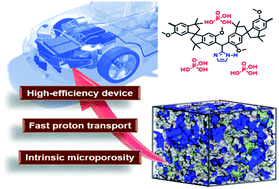Alkaline polymers of intrinsic microporosity: high-conduction and low-loss anhydrous proton exchange membranes for energy conversion†
Abstract
The development of anhydrous high-temperature proton-exchange membranes (HT-PEMs) combining durable high proton conductivity and modest mechanical properties is a huge challenge to macromolecular design and engineering. HT-PEMs with microporous structures, constructed by the inefficient chain packing of contorted and rigid polymer backbones with imidazole, are reported for the first time. It is found that the widespread and interconnected microporosity of the polymers endows the HT-PEMs with an excellent phosphoric acid (PA) doping level (ADL) and a corresponding superhigh proton conductivity, as well as suitable mechanical properties and PA-retention ability. An outstanding proton conductivity of 330.3 mS cm−1 is obtained at 180 °C under an anhydrous atmosphere, which is superior to those of reported HT-PEMs with far higher ADLs (<260 mS cm−1). The high and stable proton conductivity appears to be related to the interconnected intrinsic microporosity, which increases the PA storage and provides proton-carriers with several highways for fast transport.



 Please wait while we load your content...
Please wait while we load your content...